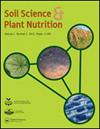Interactive effect of parent material and topography on spatial variability of paddy soil material characteristics in the alluvial plain
IF 1.8
4区 农林科学
Q3 ENVIRONMENTAL SCIENCES
引用次数: 0
Abstract
ABSTRACT To investigate the interactive effects of parent material and topography as soil forming factors, we examined the distribution of soil materials in an alluvial plain, where two types of surface geology were situated upstream and different parent materials supplied accordingly. We hypothesized that these two types of parent material make it possible to trace alluvial processes by analyzing their spatial distribution based on soil physicochemical properties. We collected 101 soil samples from the alluvial plain and nine soil samples from two types of unmixed upstream areas, i.e., granite and mélange. Particle size distributions and total concentrations of 32 elements were analyzed for spatial variabilities. Elemental composition of unmixed upstream samples and isarithmic maps of elemental composition of the soils in the alluvial plain based on geostatistical analysis revealed that gravel, coarse sand and total Na, Al, K, Ca, and Mn concentrations were higher at the southern part close to granite rock areas, whereas silt+clay content and total C, N, Mg, Ti, and Fe concentrations were higher at the northern part close to the mélange area, suggesting strong influence from parent material. In contrast, fine sand content and total P and Si concentrations showed west-east trends, suggesting topography effects reflecting particle size selection. Directional semivariograms suggest coarse sand and silt+clay content, as well as total C, N, Na, Mg, Al, K, Ca, Ti, and Mn concentrations were more strongly affected by parent material, whereas gravel and fine sand and total P concentration were more strongly affected by topography. Accordingly, the combination of elemental composition analysis and geostatistics revealed that the contribution of parent material and topography to total elemental contents in paddy surface soils in the alluvial plain varied among elements. In conclusion, evaluation of the interactive effects of parent material and topography on spatial variability of soil material characteristics enabled better understanding of soil formation processes and their potential fertility.母质与地形对冲积平原水稻土物质特征空间变异的交互作用
摘要为探讨母质与地形作为土壤形成因子的相互作用,研究了上游两种地表地质类型和不同母质供给的冲积平原土壤物质的分布。我们假设这两种类型的母质可以通过分析土壤物理化学性质的空间分布来追踪冲积过程。我们从冲积平原采集了101份土壤样品,并从花岗岩和马姆萨兰格两种未混合的上游地区采集了9份土壤样品。分析了32种元素的粒径分布和总浓度的空间变异性。未混合上游样品的元素组成和基于地统计学分析的冲积平原土壤元素组成等数图显示,砾石、粗砂和总Na、Al、K、Ca和Mn浓度在靠近花岗岩区域的南部较高,而粉土+粘土含量和总C、N、Mg、Ti和Fe浓度在靠近msamuange区域的北部较高,表明母质的影响较大。细砂含量和全磷、全硅含量呈西向东变化趋势,表明地形效应反映了粒径的选择。方向半变异图显示,粗砂和粉砂+粘土含量以及总C、N、Na、Mg、Al、K、Ca、Ti和Mn浓度受母质影响更大,而砾石和细砂以及总P浓度受地形影响更大。因此,元素组成分析与地质统计学相结合揭示了冲积平原稻田表层土壤中母质和地形对总元素含量的贡献各不相同。综上所述,评价母质和地形对土壤物质特征空间变异性的交互作用有助于更好地了解土壤形成过程及其潜在肥力。
本文章由计算机程序翻译,如有差异,请以英文原文为准。
求助全文
约1分钟内获得全文
求助全文
来源期刊

Soil Science and Plant Nutrition
农林科学-农艺学
CiteScore
4.80
自引率
15.00%
发文量
56
审稿时长
18-36 weeks
期刊介绍:
Soil Science and Plant Nutrition is the official English journal of the Japanese Society of Soil Science and Plant Nutrition (JSSSPN), and publishes original research and reviews in soil physics, chemistry and mineralogy; soil biology; plant nutrition; soil genesis, classification and survey; soil fertility; fertilizers and soil amendments; environment; socio cultural soil science. The Journal publishes full length papers, short papers, and reviews.
 求助内容:
求助内容: 应助结果提醒方式:
应助结果提醒方式:


